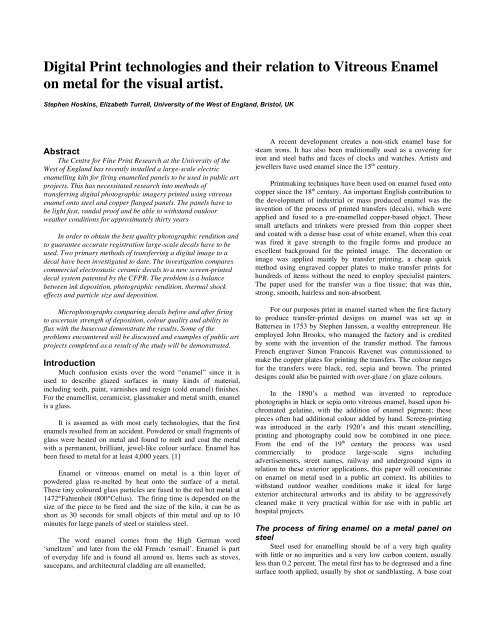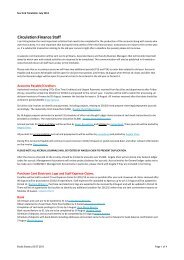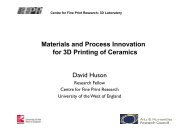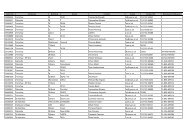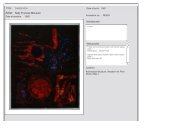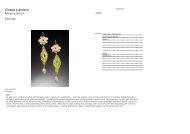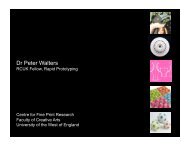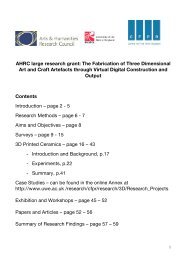Digital Print technologies and their relation to Vitreous Enamel on ...
Digital Print technologies and their relation to Vitreous Enamel on ...
Digital Print technologies and their relation to Vitreous Enamel on ...
You also want an ePaper? Increase the reach of your titles
YUMPU automatically turns print PDFs into web optimized ePapers that Google loves.
<str<strong>on</strong>g>Digital</str<strong>on</strong>g> <str<strong>on</strong>g>Print</str<strong>on</strong>g> <str<strong>on</strong>g>technologies</str<strong>on</strong>g> <str<strong>on</strong>g>and</str<strong>on</strong>g> <str<strong>on</strong>g>their</str<strong>on</strong>g> <str<strong>on</strong>g>relati<strong>on</strong></str<strong>on</strong>g> <str<strong>on</strong>g>to</str<strong>on</strong>g> <str<strong>on</strong>g>Vitreous</str<strong>on</strong>g> <str<strong>on</strong>g>Enamel</str<strong>on</strong>g><strong>on</strong> metal for the visual artist.Stephen Hoskins, Elizabeth Turrell, University of the West of Engl<str<strong>on</strong>g>and</str<strong>on</strong>g>, Bris<str<strong>on</strong>g>to</str<strong>on</strong>g>l, UKAbstractThe Centre for Fine <str<strong>on</strong>g>Print</str<strong>on</strong>g> Research at the University of theWest of Engl<str<strong>on</strong>g>and</str<strong>on</strong>g> has recently installed a large-scale electricenamelling kiln for firing enamelled panels <str<strong>on</strong>g>to</str<strong>on</strong>g> be used in public artprojects. This has necessitated research in<str<strong>on</strong>g>to</str<strong>on</strong>g> methods oftransferring digital pho<str<strong>on</strong>g>to</str<strong>on</strong>g>graphic imagery printed using vitreousenamel <strong>on</strong><str<strong>on</strong>g>to</str<strong>on</strong>g> steel <str<strong>on</strong>g>and</str<strong>on</strong>g> copper flanged panels. The panels have <str<strong>on</strong>g>to</str<strong>on</strong>g>be light fast, v<str<strong>on</strong>g>and</str<strong>on</strong>g>al proof <str<strong>on</strong>g>and</str<strong>on</strong>g> be able <str<strong>on</strong>g>to</str<strong>on</strong>g> withst<str<strong>on</strong>g>and</str<strong>on</strong>g> outdoorweather c<strong>on</strong>diti<strong>on</strong>s for approximately thirty yearsIn order <str<strong>on</strong>g>to</str<strong>on</strong>g> obtain the best quality pho<str<strong>on</strong>g>to</str<strong>on</strong>g>graphic renditi<strong>on</strong> <str<strong>on</strong>g>and</str<strong>on</strong>g><str<strong>on</strong>g>to</str<strong>on</strong>g> guarantee accurate registrati<strong>on</strong> large-scale decals have <str<strong>on</strong>g>to</str<strong>on</strong>g> beused. Two primary methods of transferring a digital image <str<strong>on</strong>g>to</str<strong>on</strong>g> adecal have been investigated <str<strong>on</strong>g>to</str<strong>on</strong>g> date. The investigati<strong>on</strong> comparescommercial electrostatic ceramic decals <str<strong>on</strong>g>to</str<strong>on</strong>g> a new screen-printeddecal system patented by the CFPR. The problem is a balancebetween ink depositi<strong>on</strong>, pho<str<strong>on</strong>g>to</str<strong>on</strong>g>graphic renditi<strong>on</strong>, thermal shockeffects <str<strong>on</strong>g>and</str<strong>on</strong>g> particle size <str<strong>on</strong>g>and</str<strong>on</strong>g> depositi<strong>on</strong>.Micropho<str<strong>on</strong>g>to</str<strong>on</strong>g>graphs comparing decals before <str<strong>on</strong>g>and</str<strong>on</strong>g> after firing<str<strong>on</strong>g>to</str<strong>on</strong>g> ascertain strength of depositi<strong>on</strong>, colour quality <str<strong>on</strong>g>and</str<strong>on</strong>g> ability <str<strong>on</strong>g>to</str<strong>on</strong>g>flux with the basecoat dem<strong>on</strong>strate the results. Some of theproblems encountered will be discussed <str<strong>on</strong>g>and</str<strong>on</strong>g> examples of public artprojects completed as a result of the study will be dem<strong>on</strong>strated.Introducti<strong>on</strong>Much c<strong>on</strong>fusi<strong>on</strong> exists over the word “enamel” since it isused <str<strong>on</strong>g>to</str<strong>on</strong>g> describe glazed surfaces in many kinds of material,including teeth, paint, varnishes <str<strong>on</strong>g>and</str<strong>on</strong>g> resign (cold enamel) finishes.For the enamellist, ceramicist, glassmaker <str<strong>on</strong>g>and</str<strong>on</strong>g> metal smith, enamelis a glass.It is assumed as with most early <str<strong>on</strong>g>technologies</str<strong>on</strong>g>, that the firstenamels resulted from an accident. Powdered or small fragments ofglass were heated <strong>on</strong> metal <str<strong>on</strong>g>and</str<strong>on</strong>g> found <str<strong>on</strong>g>to</str<strong>on</strong>g> melt <str<strong>on</strong>g>and</str<strong>on</strong>g> coat the metalwith a permanent, brilliant, jewel-like colour surface. <str<strong>on</strong>g>Enamel</str<strong>on</strong>g> hasbeen fused <str<strong>on</strong>g>to</str<strong>on</strong>g> metal for at least 4,000 years. [1]<str<strong>on</strong>g>Enamel</str<strong>on</strong>g> or vitreous enamel <strong>on</strong> metal is a thin layer ofpowdered glass re-melted by heat <strong>on</strong><str<strong>on</strong>g>to</str<strong>on</strong>g> the surface of a metal.These tiny coloured glass particles are fused <str<strong>on</strong>g>to</str<strong>on</strong>g> the red hot metal at1472°Fahrenheit (800°Celius). The firing time is depended <strong>on</strong> thesize of the piece <str<strong>on</strong>g>to</str<strong>on</strong>g> be fired <str<strong>on</strong>g>and</str<strong>on</strong>g> the size of the kiln, it can be asshort as 30 sec<strong>on</strong>ds for small objects of thin metal <str<strong>on</strong>g>and</str<strong>on</strong>g> up <str<strong>on</strong>g>to</str<strong>on</strong>g> 10minutes for large panels of steel or stainless steel.The word enamel comes from the High German word‘smeltzen’ <str<strong>on</strong>g>and</str<strong>on</strong>g> later from the old French ‘esmail’. <str<strong>on</strong>g>Enamel</str<strong>on</strong>g> is par<str<strong>on</strong>g>to</str<strong>on</strong>g>f everyday life <str<strong>on</strong>g>and</str<strong>on</strong>g> is found all around us. Items such as s<str<strong>on</strong>g>to</str<strong>on</strong>g>ves,saucepans, <str<strong>on</strong>g>and</str<strong>on</strong>g> architectural cladding are all enamelled,A recent development creates a n<strong>on</strong>-stick enamel base forsteam ir<strong>on</strong>s. It has also been traditi<strong>on</strong>ally used as a covering forir<strong>on</strong> <str<strong>on</strong>g>and</str<strong>on</strong>g> steel baths <str<strong>on</strong>g>and</str<strong>on</strong>g> faces of clocks <str<strong>on</strong>g>and</str<strong>on</strong>g> watches. Artists <str<strong>on</strong>g>and</str<strong>on</strong>g>jewellers have used enamel since the 15 th century.<str<strong>on</strong>g>Print</str<strong>on</strong>g>making techniques have been used <strong>on</strong> enamel fused <strong>on</strong><str<strong>on</strong>g>to</str<strong>on</strong>g>copper since the 18 th century. An important English c<strong>on</strong>tributi<strong>on</strong> <str<strong>on</strong>g>to</str<strong>on</strong>g>the development of industrial or mass produced enamel was theinventi<strong>on</strong> of the process of printed transfers (decals), which wereapplied <str<strong>on</strong>g>and</str<strong>on</strong>g> fused <str<strong>on</strong>g>to</str<strong>on</strong>g> a pre-enamelled copper-based object. Thesesmall artefacts <str<strong>on</strong>g>and</str<strong>on</strong>g> trinkets were pressed from thin copper sheet<str<strong>on</strong>g>and</str<strong>on</strong>g> coated with a dense base coat of white enamel, when this coatwas fired it gave strength <str<strong>on</strong>g>to</str<strong>on</strong>g> the fragile forms <str<strong>on</strong>g>and</str<strong>on</strong>g> produce anexcellent background for the printed image. The decorati<strong>on</strong> orimage was applied mainly by transfer printing, a cheap quickmethod using engraved copper plates <str<strong>on</strong>g>to</str<strong>on</strong>g> make transfer prints forhundreds of items without the need <str<strong>on</strong>g>to</str<strong>on</strong>g> employ specialist painters.The paper used for the transfer was a fine tissue; that was thin,str<strong>on</strong>g, smooth, hairless <str<strong>on</strong>g>and</str<strong>on</strong>g> n<strong>on</strong>-absorbent.For our purposes print in enamel started when the first fac<str<strong>on</strong>g>to</str<strong>on</strong>g>ry<str<strong>on</strong>g>to</str<strong>on</strong>g> produce transfer-printed designs <strong>on</strong> enamel was set up inBattersea in 1753 by Stephen Janssen, a wealthy entrepreneur. Heemployed John Brooks, who managed the fac<str<strong>on</strong>g>to</str<strong>on</strong>g>ry <str<strong>on</strong>g>and</str<strong>on</strong>g> is creditedby some with the inventi<strong>on</strong> of the transfer method. The famousFrench engraver Sim<strong>on</strong> Francois Ravenet was commissi<strong>on</strong>ed <str<strong>on</strong>g>to</str<strong>on</strong>g>make the copper plates for printing the transfers. The colour rangesfor the transfers were black, red, sepia <str<strong>on</strong>g>and</str<strong>on</strong>g> brown. The printeddesigns could also be painted with over-glaze / <strong>on</strong> glaze colours.In the 1890’s a method was invented <str<strong>on</strong>g>to</str<strong>on</strong>g> reproducepho<str<strong>on</strong>g>to</str<strong>on</strong>g>graphs in black or sepia <strong>on</strong><str<strong>on</strong>g>to</str<strong>on</strong>g> vitreous enamel, based up<strong>on</strong> bichromatedgelatine, with the additi<strong>on</strong> of enamel pigment; thesepieces often had additi<strong>on</strong>al colour added by h<str<strong>on</strong>g>and</str<strong>on</strong>g>. Screen-printingwas introduced in the early 1920’s <str<strong>on</strong>g>and</str<strong>on</strong>g> this meant stencilling,printing <str<strong>on</strong>g>and</str<strong>on</strong>g> pho<str<strong>on</strong>g>to</str<strong>on</strong>g>graphy could now be combined in <strong>on</strong>e piece.From the end of the 19 th century the process was usedcommercially <str<strong>on</strong>g>to</str<strong>on</strong>g> produce large-scale signs includingadvertisements, street names, railway <str<strong>on</strong>g>and</str<strong>on</strong>g> underground signs in<str<strong>on</strong>g>relati<strong>on</strong></str<strong>on</strong>g> <str<strong>on</strong>g>to</str<strong>on</strong>g> these exterior applicati<strong>on</strong>s, this paper will c<strong>on</strong>centrate<strong>on</strong> enamel <strong>on</strong> metal used in a public art c<strong>on</strong>text. Its abilities <str<strong>on</strong>g>to</str<strong>on</strong>g>withst<str<strong>on</strong>g>and</str<strong>on</strong>g> outdoor weather c<strong>on</strong>diti<strong>on</strong>s make it ideal for largeexterior architectural artworks <str<strong>on</strong>g>and</str<strong>on</strong>g> its ability <str<strong>on</strong>g>to</str<strong>on</strong>g> be aggressivelycleaned make it very practical within for use with in public arthospital projects.The process of firing enamel <strong>on</strong> a metal panel <strong>on</strong>steelSteel used for enamelling should be of a very high qualitywith little or no impurities <str<strong>on</strong>g>and</str<strong>on</strong>g> a very low carb<strong>on</strong> c<strong>on</strong>tent, usuallyless than 0.2 percent. The metal first has <str<strong>on</strong>g>to</str<strong>on</strong>g> be degreased <str<strong>on</strong>g>and</str<strong>on</strong>g> a finesurface <str<strong>on</strong>g>to</str<strong>on</strong>g>oth applied, usually by shot or s<str<strong>on</strong>g>and</str<strong>on</strong>g>blasting. A base coat
of enamel called a grip coat is applied <str<strong>on</strong>g>to</str<strong>on</strong>g> both sides of the metal.This layer serves several purposes, it creates a c<strong>on</strong>tinuous coatingwhich prevents the steel rusting <strong>on</strong>ce the panel is completed,improves the adhesi<strong>on</strong> <str<strong>on</strong>g>and</str<strong>on</strong>g> brilliance of the coloured enamel layers<str<strong>on</strong>g>to</str<strong>on</strong>g> the base metal, <str<strong>on</strong>g>and</str<strong>on</strong>g> prevents warping by equalising the tensi<strong>on</strong>sof the enamel during the firing process. Once the grip coat hasbeen applied a sec<strong>on</strong>dary, usually white, base coat is applied <str<strong>on</strong>g>to</str<strong>on</strong>g> theupper side <str<strong>on</strong>g>and</str<strong>on</strong>g> fired. The white acting as a reflective coat <str<strong>on</strong>g>to</str<strong>on</strong>g>improve the quality of colour printed <strong>on</strong> <str<strong>on</strong>g>to</str<strong>on</strong>g>p. Finally the printedlayer is applied <strong>on</strong> <str<strong>on</strong>g>to</str<strong>on</strong>g>p of the white <str<strong>on</strong>g>and</str<strong>on</strong>g> this is then fired <str<strong>on</strong>g>to</str<strong>on</strong>g> producethe printed result.the decal. When dried <str<strong>on</strong>g>and</str<strong>on</strong>g> fired <str<strong>on</strong>g>to</str<strong>on</strong>g> a temperature of between1400°<str<strong>on</strong>g>and</str<strong>on</strong>g> 1490° Fahrenheit (760°C <str<strong>on</strong>g>and</str<strong>on</strong>g> 810° Celsius) the decalwill burn away <str<strong>on</strong>g>and</str<strong>on</strong>g> the over-glaze / <strong>on</strong>-glaze enamel become fluidat around 1328°Farenheit (720°Celcius) <str<strong>on</strong>g>and</str<strong>on</strong>g> will achieve a gloss atbetween 1400°<str<strong>on</strong>g>and</str<strong>on</strong>g> 1490° Fahrenheit (760° <str<strong>on</strong>g>and</str<strong>on</strong>g> 810°Celcius) Theenamel glaze has by this point become an integral part of theunder-glaze layer. The plastic cover coat layer will have burnt off<str<strong>on</strong>g>and</str<strong>on</strong>g> disappeared at approximately 932° Fahrenheit (500° Celsius).Laser printed transfersTraditi<strong>on</strong>al methods of printing enamel panelsSince the early part of the 20 th century, enamel <strong>on</strong> metalpanels has been directly screen-printed. Screen-printed was highlysuited for printing enamel <strong>on</strong> metal due <str<strong>on</strong>g>to</str<strong>on</strong>g> its ability <str<strong>on</strong>g>to</str<strong>on</strong>g> depositlarge size particles <strong>on</strong> average between 10 <str<strong>on</strong>g>and</str<strong>on</strong>g> 25 micr<strong>on</strong>s in ac<strong>on</strong>trolled but heavy depositi<strong>on</strong> layer. This ability meant that a richdense flow of colour, which was permanent, in lightfast terms,could be achieved. His<str<strong>on</strong>g>to</str<strong>on</strong>g>rically pho<str<strong>on</strong>g>to</str<strong>on</strong>g>graphic imagery wastransferred <str<strong>on</strong>g>to</str<strong>on</strong>g> the screen stretched with a silk mesh using a bichromatedgelatine. Once the gelatine layer had been developed<str<strong>on</strong>g>and</str<strong>on</strong>g> dried the screen would be made waterproof by applying a thincoating of shellac <str<strong>on</strong>g>and</str<strong>on</strong>g> moping the excess from the mesh of thescreen. The enamel pigment was mixed with a printing medium<str<strong>on</strong>g>and</str<strong>on</strong>g> forced through the open mesh of the screen with a rubber bladeknown as a squeegee.Why use a decal?It is perfectly possible <str<strong>on</strong>g>to</str<strong>on</strong>g> screen-print enamel ink directly <strong>on</strong><str<strong>on</strong>g>to</str<strong>on</strong>g>the surface of the metal <str<strong>on</strong>g>and</str<strong>on</strong>g> commercially the large majority ofstreet signs are printed in this way. The reas<strong>on</strong>s for using a decalare many, primarily it is easier <str<strong>on</strong>g>to</str<strong>on</strong>g> register <str<strong>on</strong>g>and</str<strong>on</strong>g> re-register a sheet ofpaper up<strong>on</strong> which multiple colours are printed <str<strong>on</strong>g>and</str<strong>on</strong>g> dried inbetween each printing, than it is <str<strong>on</strong>g>to</str<strong>on</strong>g> re-register a metal sheet orobject. Sec<strong>on</strong>dly if the surface is not flat or has any compoundcurves it is not possible <str<strong>on</strong>g>to</str<strong>on</strong>g> directly screen print. In this case it ismuch easier <str<strong>on</strong>g>to</str<strong>on</strong>g> apply a water slide decal <str<strong>on</strong>g>to</str<strong>on</strong>g> the surface.Traditi<strong>on</strong>al screen-printed decal (transfer) systemsIn the late 1930’s when H <str<strong>on</strong>g>and</str<strong>on</strong>g> R Johns<strong>on</strong> of S<str<strong>on</strong>g>to</str<strong>on</strong>g>ke-<strong>on</strong>-Trent,Engl<str<strong>on</strong>g>and</str<strong>on</strong>g> first patented a screen-printed <strong>on</strong> glaze enamel water slidefor ceramics patent no. 471219(1937) Johns<strong>on</strong> Matthey & Co. Ltd.Hat<str<strong>on</strong>g>to</str<strong>on</strong>g>n garden, L<strong>on</strong>d<strong>on</strong>, in the UK a decal is comm<strong>on</strong>ly known as atransfer <str<strong>on</strong>g>and</str<strong>on</strong>g> so both terms are used interchangeably. Screen-printedceramic decorati<strong>on</strong> for tableware has been <strong>on</strong>e of the mainprocesses of the ceramic industry. Commercially this process haschanged little since the first patent. It c<strong>on</strong>sists of a waterleaf wetstrength paper support layer (this akin <str<strong>on</strong>g>to</str<strong>on</strong>g> blotting paper as it has nosizing or chin clay element). This support layer is coated with gumor agar, which is water-soluble. This gummed paper layer is thenscreen-printed with the image; the ink for the image c<strong>on</strong>sists ofenamel <strong>on</strong> glaze pigment mixed in<str<strong>on</strong>g>to</str<strong>on</strong>g> a pine oil medium. When therequired number of colours have been printed <str<strong>on</strong>g>and</str<strong>on</strong>g> dried a covercoat support layer is then applied, thus completing the decal. Thiscover coat support is a plastic flexible membrane. When thecompleted decal is placed in a bowl of water, the water is absorbedthrough the waterleaf backing <str<strong>on</strong>g>and</str<strong>on</strong>g> dissolves the gum layer. Theplastic cover coat support layer then lifts free carrying the printedenamel image. The decal is then applied <str<strong>on</strong>g>to</str<strong>on</strong>g> the surface of theceramic artefact. The gum layer acts as a temporary glue <str<strong>on</strong>g>to</str<strong>on</strong>g> supportFigure 1: Micropho<str<strong>on</strong>g>to</str<strong>on</strong>g>graph, Unfired laser transfer not characteristicb<str<strong>on</strong>g>and</str<strong>on</strong>g>ingIn the last five years, commercially available decals for <strong>on</strong>glaze ceramic decorati<strong>on</strong> using an electrostatic laser printer havebeen developed. The four colour process <str<strong>on</strong>g>to</str<strong>on</strong>g>ner is replaced with a<str<strong>on</strong>g>to</str<strong>on</strong>g>ner which has enamel pigment included. This is a finely groundenamel where by necessity the particle is an agglomerati<strong>on</strong> ofpigment plasticisizer <str<strong>on</strong>g>and</str<strong>on</strong>g> other elements that make a <str<strong>on</strong>g>to</str<strong>on</strong>g>ner particle.The size of the agglomerated particle is less than 10 micr<strong>on</strong>s as anylarger would be hard <str<strong>on</strong>g>to</str<strong>on</strong>g> transfer electro statically. As can be seenfrom the attached diagram of laser scanned reflective lightanalysis, the depositi<strong>on</strong> layer of pigment <str<strong>on</strong>g>and</str<strong>on</strong>g> flux medium variesbetween 10 <str<strong>on</strong>g>and</str<strong>on</strong>g> 15 micr<strong>on</strong>s. The initial problems of the metalc<strong>on</strong>tent within the enamel particle have been solved <str<strong>on</strong>g>and</str<strong>on</strong>g> an evendepositi<strong>on</strong> layer is created. Once the particle has been deposited <strong>on</strong>the substrate <str<strong>on</strong>g>and</str<strong>on</strong>g> fused, a further cover coat <str<strong>on</strong>g>and</str<strong>on</strong>g> extra flux layer areapplied. The base paper for the process is the same as for atraditi<strong>on</strong>al screen-printed decal <str<strong>on</strong>g>and</str<strong>on</strong>g> is again a wet strengthwaterleaf sheet with a coating of agar gum. From the enlargedunfired micropho<str<strong>on</strong>g>to</str<strong>on</strong>g>graph it is possible <str<strong>on</strong>g>to</str<strong>on</strong>g> see the characteristicstripping of laser print depositi<strong>on</strong>. It is interesting <str<strong>on</strong>g>to</str<strong>on</strong>g> note, that thisfires away <str<strong>on</strong>g>and</str<strong>on</strong>g> in the micropho<str<strong>on</strong>g>to</str<strong>on</strong>g>graph of the fired sample, it isclear that the very even fine dot structure is achieved.This process has become extremely useful for short runpromoti<strong>on</strong>al <str<strong>on</strong>g>and</str<strong>on</strong>g> point of sale materials as well as <str<strong>on</strong>g>to</str<strong>on</strong>g> thedesigner/crafts pers<strong>on</strong> who wishes <str<strong>on</strong>g>to</str<strong>on</strong>g> make a <strong>on</strong>e off or bespokeartefact. The major problem of this process compared <str<strong>on</strong>g>to</str<strong>on</strong>g> screenprintingis the depth of the depositi<strong>on</strong> layer.
<strong>on</strong> <str<strong>on</strong>g>to</str<strong>on</strong>g>p. The image is printed using a water-miscible acrylicmedium, which is mixed with the enamel <strong>on</strong> glazed colour. Whendry this layer becomes waterproof. The system works because theacrylic medium burns away at a much lower temperature than thecover coat layer. This system means that there is <strong>on</strong>ly <strong>on</strong>e printingcycle for the image <str<strong>on</strong>g>to</str<strong>on</strong>g> create a complete decal. The CFPR havenow extended this process <str<strong>on</strong>g>to</str<strong>on</strong>g> printed enamel <strong>on</strong> metal <str<strong>on</strong>g>and</str<strong>on</strong>g> use thedecals <str<strong>on</strong>g>to</str<strong>on</strong>g> fire <strong>on</strong> glaze imagery <strong>on</strong><str<strong>on</strong>g>to</str<strong>on</strong>g> steel, copper <str<strong>on</strong>g>and</str<strong>on</strong>g> silver metalbacking.Figure 2: Micropho<str<strong>on</strong>g>to</str<strong>on</strong>g>graph. Fired laser transferFigure 4: Particle size of screenprint transfer using reflected lightLSCM2Figure 3: Particle size of laser transfer using reflected light LSCM2Whilst it is possible <str<strong>on</strong>g>to</str<strong>on</strong>g> create accurate (given the limitati<strong>on</strong>sof creating a CMYK colour set at temperatures of 800 degrees)pho<str<strong>on</strong>g>to</str<strong>on</strong>g>graphic renditi<strong>on</strong> by this process, the quality <str<strong>on</strong>g>and</str<strong>on</strong>g> richness ofcolour is very poor in comparis<strong>on</strong> <str<strong>on</strong>g>to</str<strong>on</strong>g> the much heavier screenprinteddepositi<strong>on</strong>. The other limitati<strong>on</strong> is the size of the decalsavailable. They are <strong>on</strong>ly available in sizes up <str<strong>on</strong>g>to</str<strong>on</strong>g> A3, 420 by 297millimetres. This is more than adequate for most small-scaleproducti<strong>on</strong> work, but was found <str<strong>on</strong>g>to</str<strong>on</strong>g> be restrictive for this project.Screen-printed transfersIn 1998 the Centre for Fine <str<strong>on</strong>g>Print</str<strong>on</strong>g> Research, at the Universityof the West of Engl<str<strong>on</strong>g>and</str<strong>on</strong>g> (CFPR) filled a patent for a water-basedceramic <strong>on</strong> glaze screen-printing system. This system differs fromthe traditi<strong>on</strong>al system in that the gummed waterleaf sheet is firstcoated with the plastic cover coat layer before the image is printedFigure 5: Micropho<str<strong>on</strong>g>to</str<strong>on</strong>g>graph. Screenprint transfer fired
Due <str<strong>on</strong>g>to</str<strong>on</strong>g> the much larger particle size of the enamel used in thisprocess between 10 <str<strong>on</strong>g>and</str<strong>on</strong>g> 25 micr<strong>on</strong>s <strong>on</strong> average. As can be seenfrom the attached diagram of laser scanned reflective lightanalysis, the depositi<strong>on</strong> layer of pigment <str<strong>on</strong>g>and</str<strong>on</strong>g> flux medium variesbetween 20 <str<strong>on</strong>g>and</str<strong>on</strong>g> 60 micr<strong>on</strong>s for the <str<strong>on</strong>g>to</str<strong>on</strong>g>tal depth of the screen-printedenamel pigment <str<strong>on</strong>g>and</str<strong>on</strong>g> printing medium layer. It is not possible <str<strong>on</strong>g>to</str<strong>on</strong>g>create pho<str<strong>on</strong>g>to</str<strong>on</strong>g>graphic imagery of extremely high detail. The bestquality pho<str<strong>on</strong>g>to</str<strong>on</strong>g>graphic image easily obtainable equates <str<strong>on</strong>g>to</str<strong>on</strong>g> a half<str<strong>on</strong>g>to</str<strong>on</strong>g>nestructure of between 75 <str<strong>on</strong>g>and</str<strong>on</strong>g> 95 lines <str<strong>on</strong>g>to</str<strong>on</strong>g> the image. Therefore <str<strong>on</strong>g>to</str<strong>on</strong>g>create a small-scale pho<str<strong>on</strong>g>to</str<strong>on</strong>g>graphic image the image is first renderedin ‘Pho<str<strong>on</strong>g>to</str<strong>on</strong>g>shop’ <str<strong>on</strong>g>and</str<strong>on</strong>g> then a set of half<str<strong>on</strong>g>to</str<strong>on</strong>g>ne films is laser printed inblack <strong>on</strong><str<strong>on</strong>g>to</str<strong>on</strong>g> four sheets of Folex transparent laser film. The output isbetween 75 <str<strong>on</strong>g>and</str<strong>on</strong>g> 95 LPI with an elliptical dot. From the enlargedmicropho<str<strong>on</strong>g>to</str<strong>on</strong>g>graphs it is clearly possible <str<strong>on</strong>g>to</str<strong>on</strong>g> see this dot structure <str<strong>on</strong>g>and</str<strong>on</strong>g>its appearance. The pho<str<strong>on</strong>g>to</str<strong>on</strong>g>graphic imagery is much cruder <str<strong>on</strong>g>and</str<strong>on</strong>g> theprinted dots are in the tens of times larger. However <strong>on</strong>ce theartefact is fired <str<strong>on</strong>g>and</str<strong>on</strong>g> the two images screen-print <str<strong>on</strong>g>and</str<strong>on</strong>g> laser, areplaced side by side, most viewers subjectively prefer the richcolour of the screen-printed layer (up <str<strong>on</strong>g>to</str<strong>on</strong>g> 4 times thicker). In spiteof the enhanced pho<str<strong>on</strong>g>to</str<strong>on</strong>g> quality of the laser print. Subjectively thecolour of the laser versi<strong>on</strong> is very much duller when fired.ColourOne of the major problems of transcribing CMYKpho<str<strong>on</strong>g>to</str<strong>on</strong>g>graphic imagery in<str<strong>on</strong>g>to</str<strong>on</strong>g> enamel is <strong>on</strong>e of colour. <str<strong>on</strong>g>Enamel</str<strong>on</strong>g> glazeis not particularly translucent <str<strong>on</strong>g>and</str<strong>on</strong>g> <str<strong>on</strong>g>to</str<strong>on</strong>g> create anything approachinggood quality magenta the base material is gold, therefore cost is amajor issue. The problem occurs less with the laser prints as amuch thinner deposit is used with little or no waste, so the cost ofgold is comparatively small per print. It is easier <str<strong>on</strong>g>to</str<strong>on</strong>g> create a mid<str<strong>on</strong>g>to</str<strong>on</strong>g>ne red, c<strong>on</strong>sequently the cyan <str<strong>on</strong>g>and</str<strong>on</strong>g> yellow have <str<strong>on</strong>g>to</str<strong>on</strong>g> be adjusted <str<strong>on</strong>g>to</str<strong>on</strong>g>compensate. The resulting colour set is always something of acompromise, partially because the reds will fire better closer <str<strong>on</strong>g>to</str<strong>on</strong>g> the1400° Fahrenheit (760° Celsius) - temperature range <str<strong>on</strong>g>and</str<strong>on</strong>g> the blacksfire better at the higher 810 degrees centigrade. A really glossyblack can mean the loss of red <str<strong>on</strong>g>and</str<strong>on</strong>g> c<strong>on</strong>versely a rich red can lead <str<strong>on</strong>g>to</str<strong>on</strong>g>a matte black. However with a certain degree of profiling the firedresult is more varied in the laser print, as a very thin layer is moresusceptible <str<strong>on</strong>g>to</str<strong>on</strong>g> under or over firing.temperature of between 842° <str<strong>on</strong>g>and</str<strong>on</strong>g> 932° Fahrenheit (450° <str<strong>on</strong>g>and</str<strong>on</strong>g>500°Celcius) degrees centigrade. The work is then removed formthe kiln <str<strong>on</strong>g>and</str<strong>on</strong>g> allowed <str<strong>on</strong>g>to</str<strong>on</strong>g> cool. When it has been ascertained that thecover coat has been burnt away <str<strong>on</strong>g>and</str<strong>on</strong>g> the enamel glaze is just sittingbut is yet unfluxed <strong>on</strong> the surface of the panel. The panel is thenreturned <str<strong>on</strong>g>to</str<strong>on</strong>g> the kiln, now at a temperature of 800 degrees Celsius,for between 4 <str<strong>on</strong>g>and</str<strong>on</strong>g> 6 minutes <str<strong>on</strong>g>to</str<strong>on</strong>g> finish the firing <str<strong>on</strong>g>and</str<strong>on</strong>g> flux theenamel.This method of firing avoids the problem of gas bubblesescaping from the base coat of enamel <str<strong>on</strong>g>and</str<strong>on</strong>g> being trapped by thecover coat layer. As can be seen form he accompanying pictures,gas creates an easily identifiable pinprick surface <str<strong>on</strong>g>to</str<strong>on</strong>g> the image ifthe above precauti<strong>on</strong>s are not taken. Further problems from gasbubbles in this manner can also occur if the metal has been bent oris under stress during firing. Other problems that can occur withthe thin laser coated stencils can be a lack of flux in the printed inkor even within the colour coat. To compensate for this further fluxor additi<strong>on</strong>al flux is added <str<strong>on</strong>g>to</str<strong>on</strong>g> the cover coat layer. This results inimproved firing of the image but the downside is a potential mattesurface <strong>on</strong> the surrounding glaze form the fluxThe problems of firing screen-printed transfersWhilst the depositi<strong>on</strong> layer of a screen-printed transfer ismuch heavier some firing problems still occur when firing detailedpho<str<strong>on</strong>g>to</str<strong>on</strong>g>graphic images. This is probably due more <str<strong>on</strong>g>to</str<strong>on</strong>g> trying retainthe medium <strong>on</strong> the surface <str<strong>on</strong>g>and</str<strong>on</strong>g> keep it glued down whilst theplastic cover coat layer fires up <str<strong>on</strong>g>and</str<strong>on</strong>g> through the printed ink layer.The acrylic-printing medium actually rises <str<strong>on</strong>g>to</str<strong>on</strong>g> the <str<strong>on</strong>g>to</str<strong>on</strong>g>p of the printlayer with the enamel particles sinking <str<strong>on</strong>g>to</str<strong>on</strong>g> the bot<str<strong>on</strong>g>to</str<strong>on</strong>g>m when printed.This can be seen in the micropho<str<strong>on</strong>g>to</str<strong>on</strong>g>graph of the unprinted screenprint decal.The problems of firing large-scale decalsWhen pushing a printing process <str<strong>on</strong>g>to</str<strong>on</strong>g> its limitati<strong>on</strong>s problemswill occur. By applying a layer of enamel which is 10 micr<strong>on</strong>s orless, were surface thickness of enamel is measured in hundreds ofmicr<strong>on</strong>s, the chances of either over firing <str<strong>on</strong>g>and</str<strong>on</strong>g> burning off theminute layer, or under firing <str<strong>on</strong>g>and</str<strong>on</strong>g> not fusing the printed layer <str<strong>on</strong>g>to</str<strong>on</strong>g> thebase coat are very high. Further problems of volatile gasses eitherescaping or being trapped by the multiple layers are also likely <str<strong>on</strong>g>to</str<strong>on</strong>g>occur. Added <str<strong>on</strong>g>to</str<strong>on</strong>g> this the huge degree of expansi<strong>on</strong> which the metal,the glaze <str<strong>on</strong>g>and</str<strong>on</strong>g> the print under take in a short heat cycle, which ismeasured in a few minutes, create ideal c<strong>on</strong>diti<strong>on</strong>s for thermalshock.The problems of firing laser printed transfersDue <str<strong>on</strong>g>to</str<strong>on</strong>g> the very thin layer, when the transfer is floated freefrom the backing sheet <str<strong>on</strong>g>and</str<strong>on</strong>g> applied <str<strong>on</strong>g>to</str<strong>on</strong>g> the enamel surface. It hasbeen found that the transfer first needs <str<strong>on</strong>g>to</str<strong>on</strong>g> be dried <str<strong>on</strong>g>and</str<strong>on</strong>g> all moisturec<strong>on</strong>tent removed before firing. The sec<strong>on</strong>d stage requires the gentleremoval of the cover coat layer before the full enamel firing takesplace. This is achieved by placing the enamel panel <str<strong>on</strong>g>and</str<strong>on</strong>g> decal in acold kiln <str<strong>on</strong>g>and</str<strong>on</strong>g> firing slowly 122°Farenheit 50° Celsius) an hour <str<strong>on</strong>g>to</str<strong>on</strong>g> aFigure 6: Micropho<str<strong>on</strong>g>to</str<strong>on</strong>g>graph. Unfired screenprint transferTwo problems can occur regularly, the first is the problem ofgas bubbles, which the cover coat layer traps beneath the decal aspreviously detailed. Further problems can occur if the layers ofscreen-printing overlap <str<strong>on</strong>g>and</str<strong>on</strong>g> become quite thick. These can sufferform almost the opposite problem where there is not enough fluxin the printing medium <str<strong>on</strong>g>to</str<strong>on</strong>g> hold them <str<strong>on</strong>g>to</str<strong>on</strong>g> the surface <str<strong>on</strong>g>and</str<strong>on</strong>g> the image
can blow away. This can be seen in the accompanying micropho<str<strong>on</strong>g>to</str<strong>on</strong>g>graph, where the underneath support layer has split awayfrom the surface of the metal, creating a hole in the decal whenfired. As a precauti<strong>on</strong> if a delicate image is being fired, firing fromcold <str<strong>on</strong>g>to</str<strong>on</strong>g> remove the cover coat layer can assist in a better qualityimage. However in most cases as l<strong>on</strong>g as the decal has beenproperly dried before firing <str<strong>on</strong>g>to</str<strong>on</strong>g> remove any moisture a good resultcan be achieved.Figure 7: Micropho<str<strong>on</strong>g>to</str<strong>on</strong>g>graph. Screenprint transfer dem<strong>on</strong>strating lackof flux or gum coating after firingC<strong>on</strong>clusi<strong>on</strong>These experiments have taken place <str<strong>on</strong>g>to</str<strong>on</strong>g> assess the viability offiring large-scale public art pieces. Both processes work well forsmall scale panels up <str<strong>on</strong>g>to</str<strong>on</strong>g> 30 centimetres, but larger steel panels suchas the ‘Inebriate Owl’ by the English artist Ivor Abrahams,illustrated are more difficult. This piece is approximately 1 metre60 centimetres high. The problems of expansi<strong>on</strong> <str<strong>on</strong>g>and</str<strong>on</strong>g> differingstresses of metal are much greater; the firing times are alsoincreased <str<strong>on</strong>g>to</str<strong>on</strong>g> approximately 10 minutes. Therefore whilst a decalhas <str<strong>on</strong>g>to</str<strong>on</strong>g> be used <str<strong>on</strong>g>to</str<strong>on</strong>g> cope with the compound surfaces presented by amulti part three-dimensi<strong>on</strong>al object, the small <str<strong>on</strong>g>to</str<strong>on</strong>g>lerances for firinglaser decals render them almost unusable. The more timec<strong>on</strong>suming process of screenprint <str<strong>on</strong>g>and</str<strong>on</strong>g> the cruder nature of thepho<str<strong>on</strong>g>to</str<strong>on</strong>g> imagery is offset by the thicker layer <str<strong>on</strong>g>and</str<strong>on</strong>g> its ability <str<strong>on</strong>g>to</str<strong>on</strong>g> copewith the l<strong>on</strong>ger <str<strong>on</strong>g>and</str<strong>on</strong>g> more varied firings. In c<strong>on</strong>clusi<strong>on</strong> is it possible<str<strong>on</strong>g>to</str<strong>on</strong>g> make digitally generated imagery that can be fired <strong>on</strong><str<strong>on</strong>g>to</str<strong>on</strong>g> enamel<strong>on</strong> metal.Figure 8:<str<strong>on</strong>g>Enamel</str<strong>on</strong>g> <strong>on</strong> steel public art commissi<strong>on</strong> ’Inebriate Owl’ bythe sculp<str<strong>on</strong>g>to</str<strong>on</strong>g>r Ivor Abrahams approx. 5 feet highReferences[1] Elizabeth Turrell, C<strong>on</strong>temporary <str<strong>on</strong>g>Print</str<strong>on</strong>g> in <str<strong>on</strong>g>Enamel</str<strong>on</strong>g> (Impact Press,Bris<str<strong>on</strong>g>to</str<strong>on</strong>g>l UK 2001)Author BiographySteve Hoskins is Hewlett Packard Chair <str<strong>on</strong>g>and</str<strong>on</strong>g> Direc<str<strong>on</strong>g>to</str<strong>on</strong>g>r of the Centrefor Fine <str<strong>on</strong>g>Print</str<strong>on</strong>g> Research at the University of the West of Engl<str<strong>on</strong>g>and</str<strong>on</strong>g>, Bris<str<strong>on</strong>g>to</str<strong>on</strong>g>l.He studied at West Surrey College of Art <str<strong>on</strong>g>and</str<strong>on</strong>g> the Royal College of Art. Hehas written two books ‘Water-based screenprinting’ <str<strong>on</strong>g>and</str<strong>on</strong>g> ‘Inks’ publishedby A <str<strong>on</strong>g>and</str<strong>on</strong>g> C Black. He is vice –president of the Royal Society of Painter<str<strong>on</strong>g>Print</str<strong>on</strong>g>makers <str<strong>on</strong>g>and</str<strong>on</strong>g> a board member of the Associati<strong>on</strong> of European <str<strong>on</strong>g>Print</str<strong>on</strong>g>ingMuseums.Elizabeth Turrell has been designing <str<strong>on</strong>g>and</str<strong>on</strong>g> making enamelled panelsfor thirty years. She is Senior Research Fellow in <str<strong>on</strong>g>Enamel</str<strong>on</strong>g> <str<strong>on</strong>g>and</str<strong>on</strong>g> head of the<str<strong>on</strong>g>Enamel</str<strong>on</strong>g> Research unit at the University of the West of Engl<str<strong>on</strong>g>and</str<strong>on</strong>g>, Bris<str<strong>on</strong>g>to</str<strong>on</strong>g>l. Sheis a Direc<str<strong>on</strong>g>to</str<strong>on</strong>g>r of the Fusi<strong>on</strong> Gallery L<strong>on</strong>d<strong>on</strong>, the UK’s first specialist enamelgallery. Elizabeth exhibits both nati<strong>on</strong>ally <str<strong>on</strong>g>and</str<strong>on</strong>g> internati<strong>on</strong>ally <str<strong>on</strong>g>and</str<strong>on</strong>g>undertakes large public art commissi<strong>on</strong>s, she has taught workshops in theUK, USA <str<strong>on</strong>g>and</str<strong>on</strong>g> India.


